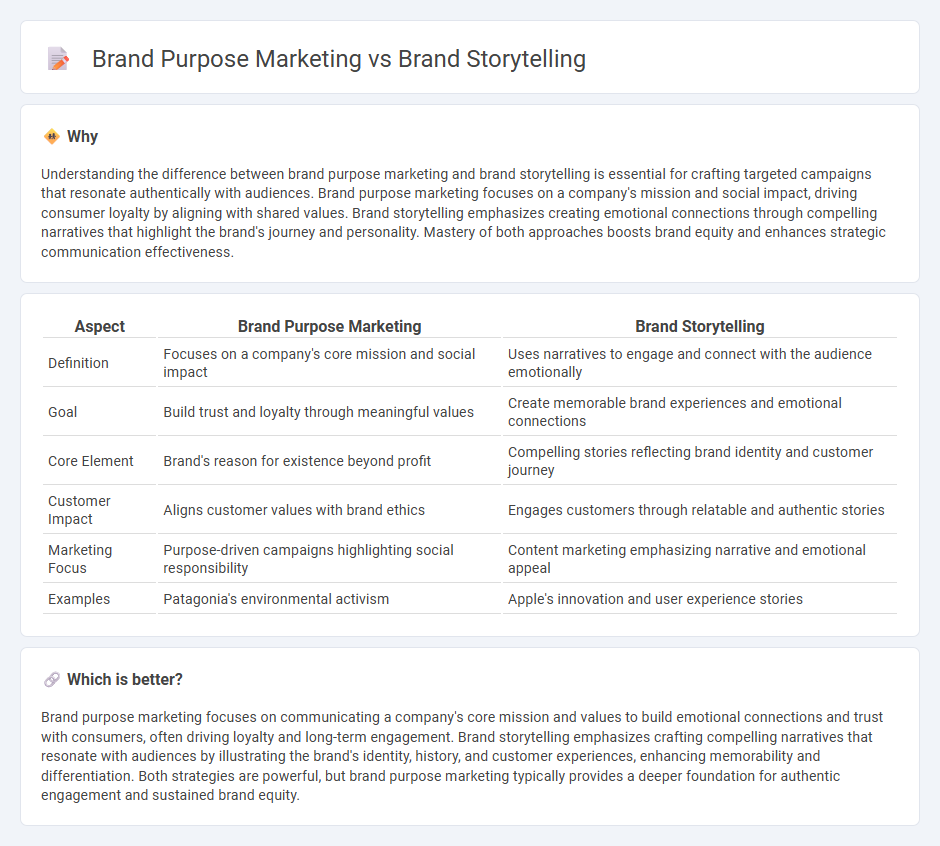
Brand purpose marketing emphasizes a company's core mission and societal impact to connect with customers on a deeper, value-driven level. Brand storytelling focuses on crafting engaging narratives around the brand's history, products, and customer experiences to build emotional resonance. Explore how integrating both strategies can elevate your marketing effectiveness.
Why it is important
Understanding the difference between brand purpose marketing and brand storytelling is essential for crafting targeted campaigns that resonate authentically with audiences. Brand purpose marketing focuses on a company's mission and social impact, driving consumer loyalty by aligning with shared values. Brand storytelling emphasizes creating emotional connections through compelling narratives that highlight the brand's journey and personality. Mastery of both approaches boosts brand equity and enhances strategic communication effectiveness.
Comparison Table
| Aspect | Brand Purpose Marketing | Brand Storytelling |
|---|---|---|
| Definition | Focuses on a company's core mission and social impact | Uses narratives to engage and connect with the audience emotionally |
| Goal | Build trust and loyalty through meaningful values | Create memorable brand experiences and emotional connections |
| Core Element | Brand's reason for existence beyond profit | Compelling stories reflecting brand identity and customer journey |
| Customer Impact | Aligns customer values with brand ethics | Engages customers through relatable and authentic stories |
| Marketing Focus | Purpose-driven campaigns highlighting social responsibility | Content marketing emphasizing narrative and emotional appeal |
| Examples | Patagonia's environmental activism | Apple's innovation and user experience stories |
Which is better?
Brand purpose marketing focuses on communicating a company's core mission and values to build emotional connections and trust with consumers, often driving loyalty and long-term engagement. Brand storytelling emphasizes crafting compelling narratives that resonate with audiences by illustrating the brand's identity, history, and customer experiences, enhancing memorability and differentiation. Both strategies are powerful, but brand purpose marketing typically provides a deeper foundation for authentic engagement and sustained brand equity.
Connection
Brand purpose marketing and brand storytelling are interconnected as both center on communicating a company's core values to build emotional connections with consumers. Brand purpose marketing defines the mission driving a company beyond profit, while brand storytelling conveys that mission through compelling narratives that engage target audiences. Together, they foster brand loyalty and differentiate companies in competitive markets by creating authentic, meaningful experiences.
Key Terms
Brand Storytelling:
Brand storytelling centers on crafting a compelling narrative that communicates a brand's history, values, and unique personality, creating emotional connections with customers. It leverages authentic stories to build trust and differentiate the brand in a crowded market. Explore how brand storytelling can transform customer engagement and loyalty.
Narrative
Brand storytelling centers on crafting compelling narratives that connect audiences emotionally with a brand's history, values, and experiences. Brand purpose marketing emphasizes a brand's reason for existence, highlighting its social, environmental, or ethical commitments to inspire loyalty and trust. Explore how integrating these approaches can elevate your brand identity and engagement strategies.
Emotional Connection
Brand storytelling crafts narratives that evoke emotions and build a relatable identity by sharing authentic experiences and values. Brand purpose marketing highlights a company's mission and social impact to inspire trust and loyalty through meaningful contributions to society. Explore how integrating both approaches can deepen emotional connections and elevate your brand's influence.
Source and External Links
Brand Storytelling: What It Is and Why It Matters - Acquia - Brand storytelling centers the customer as the main character, using relatable narratives about real-life experiences to build emotional connections, trust, and loyalty with the audience, making the brand part of a larger meaningful story rather than just promoting products.
Brand storytelling: Creating a story that resonates - Sprout Social - Effective brand storytelling involves starting with the customer as the protagonist, applying narrative techniques like characters, conflict, and resolution, and having a clear purpose to emotionally connect and increase brand recall among the audience.
Brand Storytelling: How to Connect with Your Customers - Adobe - Crafting a compelling brand story begins with defining your brand's values, mission, and target audience to create an authentic, consistent narrative that resonates deeply and builds trust with customers.
 dowidth.com
dowidth.com